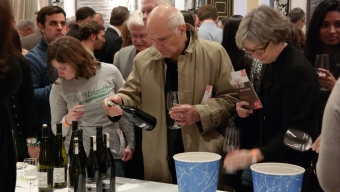Blog: Slow Wine 2015
[img src=http://www.localbozo.com/wp-content/flagallery/blog-slow-wine-2015/thumbs/thumbs_sam_0268.jpg]20SAMSUNG CSC
[img src=http://www.localbozo.com/wp-content/flagallery/blog-slow-wine-2015/thumbs/thumbs_sam_0257.jpg]30SAMSUNG CSC
[img src=http://www.localbozo.com/wp-content/flagallery/blog-slow-wine-2015/thumbs/thumbs_sam_0266.jpg]30SAMSUNG CSC
[img src=http://www.localbozo.com/wp-content/flagallery/blog-slow-wine-2015/thumbs/thumbs_sam_0271.jpg]30SAMSUNG CSC
[img src=http://www.localbozo.com/wp-content/flagallery/blog-slow-wine-2015/thumbs/thumbs_sam_0270.jpg]30SAMSUNG CSC
[img src=http://www.localbozo.com/wp-content/flagallery/blog-slow-wine-2015/thumbs/thumbs_sam_0273.jpg]40SAMSUNG CSC
[img src=http://www.localbozo.com/wp-content/flagallery/blog-slow-wine-2015/thumbs/thumbs_sam_0274.jpg]10SAMSUNG CSC
[img src=http://www.localbozo.com/wp-content/flagallery/blog-slow-wine-2015/thumbs/thumbs_sam_0279.jpg]20SAMSUNG CSC
[img src=http://www.localbozo.com/wp-content/flagallery/blog-slow-wine-2015/thumbs/thumbs_sam_0250.jpg]20SAMSUNG CSC
[img src=http://www.localbozo.com/wp-content/flagallery/blog-slow-wine-2015/thumbs/thumbs_sam_0254.jpg]30SAMSUNG CSC
[img src=http://www.localbozo.com/wp-content/flagallery/blog-slow-wine-2015/thumbs/thumbs_sam_0263.jpg]20SAMSUNG CSC
[img src=http://www.localbozo.com/wp-content/flagallery/blog-slow-wine-2015/thumbs/thumbs_sam_0260.jpg]30SAMSUNG CSC
[img src=http://www.localbozo.com/wp-content/flagallery/blog-slow-wine-2015/thumbs/thumbs_sam_0243.jpg]30SAMSUNG CSC
[img src=http://www.localbozo.com/wp-content/flagallery/blog-slow-wine-2015/thumbs/thumbs_sam_0240.jpg]40SAMSUNG CSC
[img src=http://www.localbozo.com/wp-content/flagallery/blog-slow-wine-2015/thumbs/thumbs_sam_0245.jpg]20SAMSUNG CSC
[img src=http://www.localbozo.com/wp-content/flagallery/blog-slow-wine-2015/thumbs/thumbs_sam_0248.jpg]20SAMSUNG CSC
The incredible range of Italian grapes was on full display inside the Empire Room of the Waldorf Astoria Monday evening as part of Slow Wine’s New York tasting event. Over 40 producers were offering pours that represented the Slow Food philosophy, highlighting “good, clean and fair” wines from many of Italy’s wine producing regions.  The evening session welcomed public attendees between two days of industry tastings, giving New York’s amateur winos a chance to experience some of Italy’s finest and lesser known offerings.
Our wine guide provided a map of the room, color-coded by region. Each winery was further distinguished by Slow Wine’s three-symbol system: a snail, awarded to wineries that especially reflect Slow Food values, a bottle for those wineries producing excellent quality, and a coin, given to wineries with particularly good value. Wines themselves were marked as applicable as Slow Wine, Great Wine, and Everyday Wine, largely corresponding with the winery demarcations. We attempted to sample wines from each of Italy’s largest producing regions before moving on to smaller areas, but the crowd ended up deciding where we went most of the time.
Castello di Neive and Borgogno & Figli had our favorite wines from the Piedmont region. All made from the nebbiolo grape, their offerings showed why this grape makes some of the world’s best reds. Of their three offerings, Borgogno & Figli’s Barolo Cannubi stood out as especially expressive of the typical qualities of this type of wine: full-bodied, long-lasting with hints of spices, red berries, leather and licorice and a high level of tannins. For the less bold, Castello Di Neive’s Barbaresco Santo Stefano and Barbera D’Alba maintained those same main tasting notes with slightly softer tannins and less aggressive alcohol. To our delight, their winery was also boasting the bottle symbol, indicating that we could enjoy a DOCG without breaking the bank. L’Armangia put up a good fight with its Barbera D’Astis. Its Sopra Berruti, marked as an everyday wine, begged to be enjoyed with food with its red fruits, brief tannins and moderate acidity.
Our other favorite reds of the evening were Amarone, another full-bodied red. A varietal of Valpolicella, its grapes are first dried for several months before the typical wine-making process begins. Speri’s Amarone was a good example of the structure and potency typical of the process. Perhaps it was because we had these reds first after coming in from the cold, or perhaps because they were nearest the antipasti station, we found these reds to be balanced in their richness.
While in the northeast of Italy, we stopped by Pra and Pieropan, who displayed Soaves side by side. Pieropan’s Soave Classico and La Rocca, both made from 100% garganega, showed the versatility of their estate’s vineyards. Located in the heart of Soave, Pieropan has been producing Soave for over a century, but has adopted organic farming into its viticulture to maintain the traditional style of its wines. Along with Pieropan, Pra received the snail symbol for its Soaves due to its efforts at returning to a purer and less-invasive wine making. Both producers presented wines showing the approachability of Soave as a light, mineral white perfect for pairing with food or enjoying in the warmer months.
Continuing with whites, we enjoyed a full tasting of Volpe Pasini’s wines, displaying flavors typical of the Friuli Venezia Giulia region. In addition to the ever popular Pinot Grigio, we enjoyed the local grape Ribolla Gialla, a similarly young and approachable white. From their Zuc di Volpe line, the Friuli Colli Orientali Sauvignon was marked as a “Great Wine†in our guide with good reason. Its minerality and grassy, green notes were balanced by an overall richness in mouth feel that helped soften the initial flavors. The wines echoed the qualities of German and Austrian wines just over the border, but displayed a rich, almost oily quality that was unique to the area’s varieties.
Despite our predetermined preferences for bold red wines and classically drinkable whites from the major regions, we managed to squeeze in a few more adventurous wines as well. From the Basilicata region, we enjoyed L’Atto from Cantine del Notaio, made entirely from the aglianico grape. Grown in volcanic soil, the wine was spicy with predominantly red fruits, a very drinkable red. From the southern part of Tuscany, Tenimenti D’Alessandro is somewhat surprisingly growing Syrah and Viognier. After testing multiple varietals, these were the grapes that grew best in their soil. Aged in steel and then concrete, their Syrahs maintained the typical jamminess and medium body found in varietals from other parts of the world, but had a variety of spice and warmer notes. Our favorite was Il Bosco, which had an added complexity of coffee notes.
Overall the evening was full of enjoyment, from new spins on old favorites to previously unknown grapes. While the crowd ended up pushing us away from some of the more popular wines that were originally in our game plan, we happily landed at some winemakers that we are excited to continue to explore. With Slow Food at the helm, it was not surprising that the representatives were eager to share their winery’s traditions, explorations, and deep-rooted (no pun intended) respect for their process.
- Mallory Sullivan






















